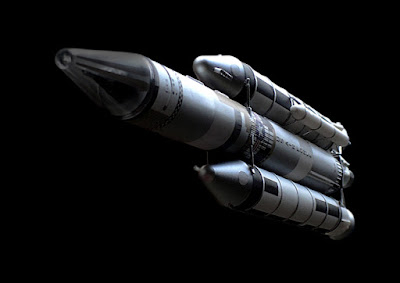
On June 18, 1965, the expendable launch system Titan IIIC flew for the first time. Used by the U.S. Air Force and NASA from 1965 to 1982, Titan IIIC was a powerful launcher.
Do you know what an expendable launch system is? These are launch vehicles that can be launched only once. This means that the components are either destroyed during re-entry or are discarded in space after launch.
Also called expendable launch vehicles (ELVS), such systems usually contain several rocket stages. As the vehicle gains altitude and speed, these stages typically are sequentially discarded as and when their fuel is exhausted.
The Titan IIIC was one such ELV. Used majorly by the U.S. Air Force and also by NASA, the rocket consisted of modified liquid-fuel first and second stages with two lateral strap-on solid rockets to enhance boost at lift-off.
Began as an ICBM
The Titan family of launch vehicles started off as a large intercontinental ballistic missile (ICBM) as the U.S. Air Force sought an ICBM that would surpass Atlas in terms of delivery capacity and sophistication. Just like the Atlas and Thor, Titan too evolved into an important family of space launch vehicles.
The development contract for what would become the Titan ICBM was issued in October 1955. It was named Titan as the name referred to any of the children of Uranus (Heaven) and Gaea (Earth) and their descendants in Greek mythology. The first Titan was test-launched on February 6, 1959, but Titan I wasn't modified for spaceflight.
Modified for Gemini Project
That first happened with Titan Il, a more powerful version of Titan I. Tested successfully in March 1962, Titan II was declared operational in 1963. Initially modified as the Gemini-Titan II to be the launch vehicle of the crewed Gemini Project, it was then used to place satellites in orbit as well.
When there was a need for rockets that were capable of carrying heavier payloads than those handled by Atlas-Centaur, the Titan III family of launch vehicles were born. The Titan IIIA was a Titan II ICBM with an added third stage called transtage, which used twin Aerojet engines and burned Aerozine 50 and nitrogen tetroxide liquid fuel.
Two strap-on boosters
Titan IIIC was an upgrade on Titan IIIA. The most important modification was the addition of two huge strap-on solid rocket boosters that were over 25m tall and 3m wide. They were capable of remarkable thrust as they were powered by burning aluminum/ammonium perchlorate solid fuel.
On June 18, 1965, the Titan IIIC was launched for the first time from Cape Canaveral, Florida with a payload of nearly 10,000 kg. From 1965 to 1982, the Air Force employed different Titan IIICs over 30 times successfully, placing a variety of military communications and reconnaissance satellites in orbit.
In all, there were only five complete or partial launch failures with Titan IIICs. It was also used successfully by NASA for a number of launches, including in 1973 to launch an Applications Technology Satellite.
As long as it was in use, the Titan IIIC was the most powerful launcher that was used by the Air Force. It remained that way until 1982, when Titan 34D, which was based on Titan IIIC, was introduced. The last flight of a Titan IIIC took place on March 6, 1982.
Picture Credit : Google

